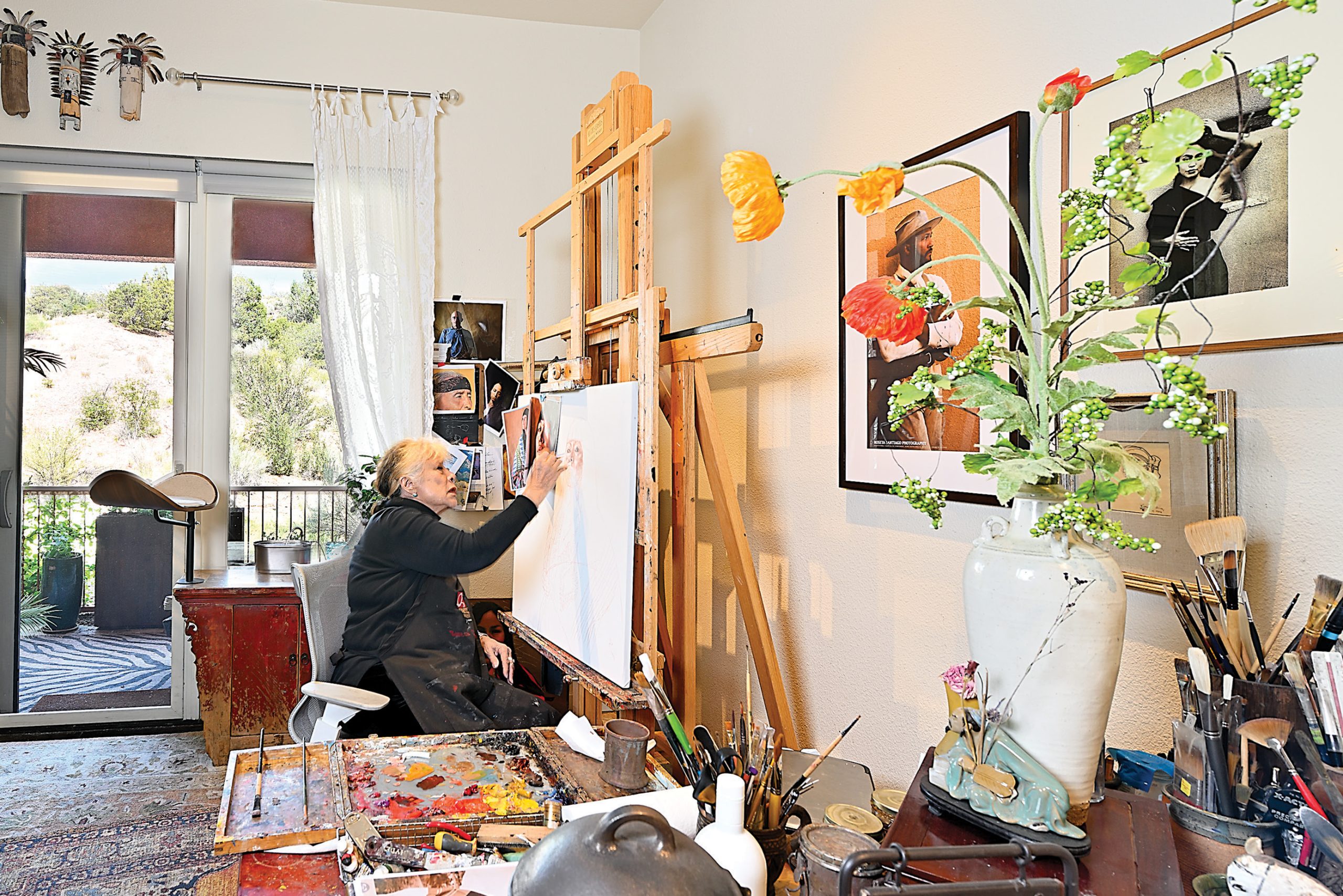
29 Oct In the Studio: What Lies Beneath the Layers
In her studio not far from the famous Santa Fe Opera, Roseta Santiago is painting a Native American figure clad in regalia. “I am drawn to Native people and I’m drawn to the energy of the Southwest,” she says. “I found it to be a pathway from the past to the present. Being able to hold and touch and see history inspires my work; I’m here as a witness to all of it.”
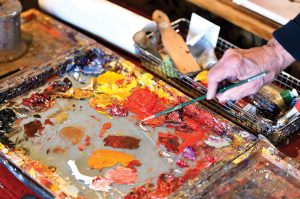
Santiago’s well-worn 20-year-old paint box can be closed for use outdoors as well as indoors.
The passion for fine art painting manifests differently for each artist. Some are devoted to a particular technique, exalting it as the pinnacle of artistic achievement. Others are invested in color theory, believing that this approach is the ultimate path to a masterpiece. And then there are the artists who strive for something intangible in their work that is not readily explainable. Santiago’s passion is manifest in each brushstroke and within the thin layers of paint that create depth on her canvases. It’s not one thing that she can describe, but many things that go into her work.
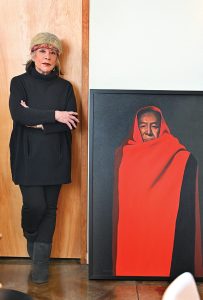
Santiago poses with a commission of her most inspirational model, Tony, whom she met through Ned Jacob in an alla prima painting exercise. Her signature “Roseta Red” color was requested by the collectors for the model’s attire.
Early in her career, Santiago was heralded for her ability to paint ancient pottery. Often, viewers held their breaths as they sought to unravel the mystery of how she accomplished not only the likeness of a pot, but also the life force of the object she presented in the painting. But Santiago says that she never painted a piece of pottery as merely an object. “My process was to become the potter to understand how they made it. I know oil painting, and I understand shape and color, which was innate, but I didn’t want to paint those ancient pots as an observer. As I painted, I followed the geometry of the pot to understand the difficulty of the materials the potter was limited to. I’d try to become the potter and understand digging clay and leaving fingerprints in it and painting designs on it with smashed yucca root. I’d let all that be absorbed into my painting.”
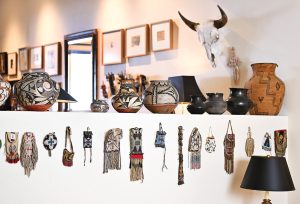
Santiago’s “first models” are her collection of pottery and beaded bags. She learned to bead in order to portray them in paint.
This life force that Santiago breathes into her work might well be explained by a passage from a book that she says changed her life. Beauty: The Invisible Embrace by Irish author John O’Donohue influenced her early on in her career, and its words still inspire her. Particularly meaningful was O’Donohue’s quote: “We were created to be creators. At its deepest heart, creativity is meant to … evoke beauty. When this desire and capacity come alive, new wells spring up in parched ground; difficulty becomes invitation and rather than striving … we fall into rhythm with its deepest urgency and passion.”
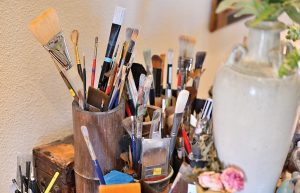
A variety of brushes are a necessity; Santiago says having the right tools is vital for creativity.
“Think about that word creation,” Santiago says. “I think of it as a point because it is invisible. Let’s say Rembrandt got it, Vermeer got there, and Rodin got there — they were experiencing the point of creation. At certain times when I’m painting, I see something being created in front of me, and I realize I’m at the same point as they were. All artists can have this experience, and when you’re there, you honor it — it’s the epitome of creation. Artists, no matter what their art may be, get to experience this if they give their whole heart and soul to it.”
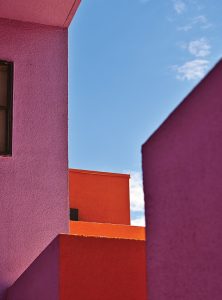
Santiago’s home and studio occupy one of 20th-century Mexican architect Ricardo Legorreta’s “tucked away” houses. His use of bold colors was an aspect the artist particularly related to.
Santiago didn’t paint portraits or figures for a long while because of the complexity she experienced trying to figure out the dynamics of each shape of pottery she painted. Fellow artist Ned Jacob [1938-2025] encouraged Santiago to capture the likeness of a figure on canvas. “The first person to challenge me to paint a figure was Ned Jacob,” she says. “He called me and said, ‘I’m in Santa Fe and I found a Native American from San Felipe named Tony. I want you to come over, I’m taking out my Blackfeet regalia for him to wear, and you can paint him alla prima.’”
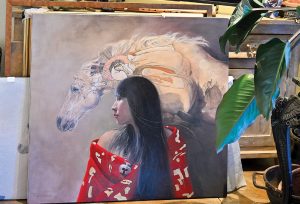
For Journey Horse, Santiago experimented with a combination of subjects. “I like the beauty of how the horse and woman interfaced to symbolize strength and resilience.”
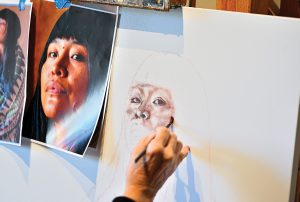
In laying in the underpainting of Tamara, a model Santiago recently rediscovered, the artist works from life and photo reference.
The challenge was that Santiago was not allowed to take photos; she had to paint the model entirely from life that day. She says that because of Jacob, whom she calls an ‘art hero,’ she was forced to push her boundaries and break out of her comfort zone. “Painting Tony that day was a euphoric experience. The beautiful color of his suntanned skin against the traditional regalia inspired me. After that, I went to Feast Day at San Felipe. Once you see 200 dancers dancing for five hours, you realize that the beauty of living history is not a movie; it’s right in front of you.”
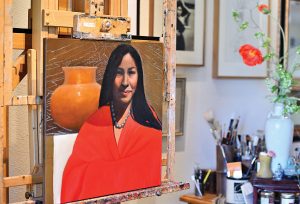
For this portrait, fellow artist Tony Abeyta introduced Santiago to Ty, the first female Diné model she’d worked with.
There was a day when Santiago decided she was ready to have a solo figurative show. “I thought, ‘If I’m going to push myself over the limit, I might as well do something I hadn’t done before,’” she says. “Thankfully, the show was a sellout, and it gave me the confidence I needed to continue painting figurative art.”
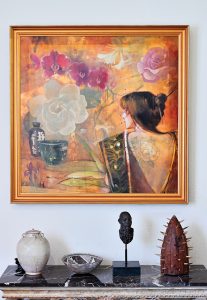
Secret Garden, by Santiago, adorns the entrance of her home. With a Japanese influence and hints of gold leaf, the painting imbues an ethereal, mystical feeling.
Santiago works from both life and photographs when painting a figure. Often, she awakens in the early morning hours, an excellent quiet time to paint. “At 5 a.m., the model is not sitting in my studio, but I have the photograph of them taken in the light in which they were captured. I can see the sweat on their face from the sun, the lines, the heat on the face, and how it reflects. All I need to know about that person at that time is in that photo,” she says.
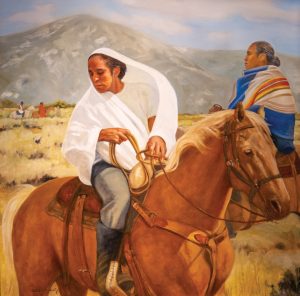
A Day in Taos, a 30 x 30-inch oil featuring Dwight Concha of the Taos Pueblo, on horseback with iconic Taos Mountain behind. Photo: Phil Velasquez
As an artist with a trained eye, Santiago says she is visually awake and always analyzing her world. “I’m questioning what I’m looking at. I’m curious to my core. It helps me not miss information that I get to paint. Also, I am fascinated by mystery, illusion, and the unknown. My art isn’t about painting the visible painting, it’s the invisible — the why and how — and then the subject, be it a model or an ancient piece of pottery.”
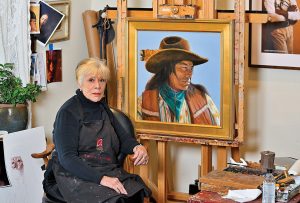
A true horseman, model, and actor Adam Joaquin Gonzales appears in his work clothes in Santiago’s Sizing Up the Situation.
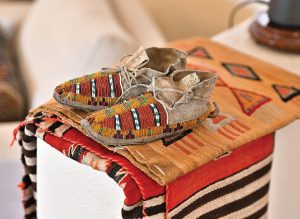
Authentic artifacts aid in the artist’s historically accurate paintings. Here, Plains Indian moccasins are perched on a rare woven cornhusk bag atop an early-19th century Diné young women’s wearing blanket.
Understanding Santiago’s work is best considered in the context of a question fellow artist John Coleman once asked her when they were both showing their work at the Eiteljorg Museum’s Quest for the West exhibit. “What is it that you’re doing to get that last note?” he asked after studying her work. She responded, “I consider the ability to capture the last note a gift … at times it feels like magic.”
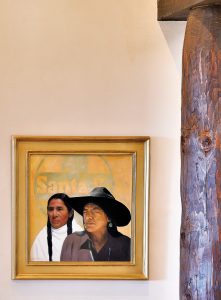
To commemorate her father’s first trip west by train with Harry Truman, Santiago featured the Santa Fe Railroad Logo. Her father served as Truman’s personal chef. In this painting, two Navajo men look into the bright sun.
Shari Morrison has been in the business of art for more than 40 years. She helped found the Scottsdale Artists’ School and the American Women Artists, and directed the Santa Fe Artists’ Medical Fund for some years.
Based in Santa Fe, New Mexico, photographer Daniel Nadelbach’s clients include Smithsonian, Whole Foods, Vogue Australia, Auberge Resorts, and Head Sportswear, among many others.





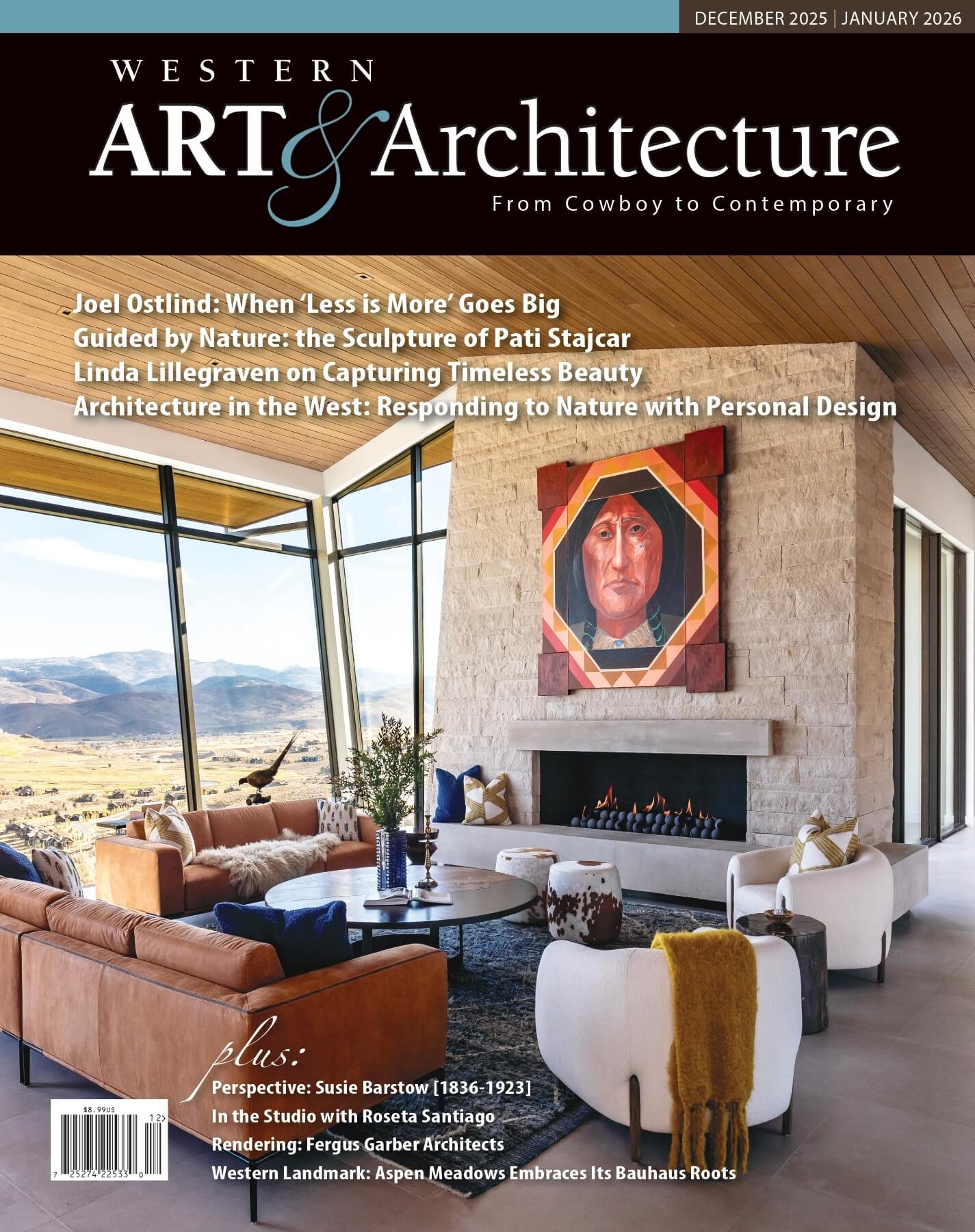
No Comments